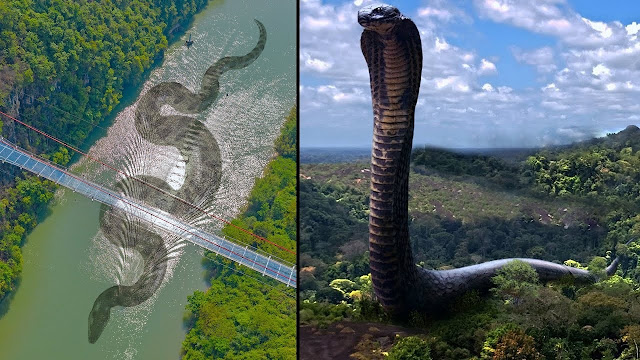Unveiling the Top 10 Largest Snakes in the World
Green Anaconda (Eunectes murinus)
The green anaconda, native to the swamps and rivers of South America, is the largest snake by weight and girth. It can grow up to 30 feet (9 meters) in length and weigh over 550 pounds (250 kilograms). With its thick body and impressive strength, the green anaconda is a formidable predator, capable of overpowering even large prey.
Reticulated Python (Python reticulatus)
The reticulated python, found in Southeast Asia, holds the title of the longest snake in the world. It can reach lengths of up to 33 feet (10 meters) and has a sleek pattern of intricate scales. Its powerful constriction allows it to subdue and consume prey as large as deer or wild pigs. These magnificent pythons are highly adaptable and can thrive in various habitats.
Burmese Python (Python bivittatus)
The Burmese python, originating from Southeast Asia, is another massive snake that can grow over 23 feet (7 meters) in length. Known for its beautiful pattern and docile nature, the Burmese python is a popular choice among snake enthusiasts. Unfortunately, it has become an invasive species in some parts of the world, posing a threat to local ecosystems.
African Rock Python (Python sebae)
The African rock python is a robust and muscular snake that can reach lengths of up to 20 feet (6 meters). Native to sub-Saharan Africa, it is known for its ambush hunting style and ability to take down large prey, including antelope and crocodiles. Despite its intimidating size, the African rock python is generally shy and non-aggressive towards humans.
Indian Python (Python Molurus)
The Indian python, also known as the Indian rock python, is one of the largest snakes found on the Indian subcontinent. It can grow up to 20 feet (6 meters) long and exhibits a striking pattern of light and dark brown markings. These pythons are skilled climbers and can be found in a variety of habitats, from grasslands to forests.
Amethystine Python (Morelia amethystine)
The amethystine python also called the scrub python, is an impressive snake native to Australia, New Guinea, and Indonesia. It can attain lengths of up to 23 feet (7 meters) and possesses beautifully iridescent skin that shimmers in hues of blue and purple. These non-venomous constrictors are arboreal, spending a significant portion of their lives in trees.
King Cobra (Ophiophagus Hannah)
The king cobra, known for its majestic appearance and potent venom, is the longest venomous snake in the world. It can grow up to 18 feet (5.5 meters) in length and can rear up and spread its iconic hood. Despite its fearsome reputation, the king cobra is generally non-aggressive and prefers to avoid confrontation whenever possible.
Eastern Diamondback Rattlesnake (Crotalus adamanteus)
The eastern diamondback rattlesnake, found in the southeastern United States, is the largest venomous snake in North America. It can reach lengths of up to 8 feet (2.4 meters) and possesses a distinctive diamond pattern on its back. With its potent venom and rattling tail, this species commands respect and plays a vital role in controlling rodent populations.
Black Mamba (Dendroaspis polylepis)
The black mamba, native to sub-Saharan Africa, is widely regarded as one of the deadliest snakes in the world. Despite its name, it is not entirely black but rather dark brown or olive in colour. Known for its incredible speed and potent neurotoxic venom, the black mamba can grow up to 14 feet (4.3 meters) in length and is a master of agility and precision.
Gaboon Viper (Bitis gabonica)
The Gaboon viper, native to the rainforests of central and western Africa, is the heaviest venomous snake in the world. While not as long as some other snakes on this list, it compensates with its stout body and striking pattern. With the largest fangs of any snake species and a venom that can cause severe tissue damage, the Gaboon viper is a formidable predator.
In Last
These top 10 biggest snakes in the world showcase the incredible diversity and adaptability of these magnificent creatures. From the massive green anaconda to the sleek reticulated python, each species possesses unique characteristics that have enabled them to thrive in their respective habitats. While they may instil a sense of awe and respect, it is important to remember that these snakes play crucial roles in maintaining the balance of our ecosystems. As we explore and appreciate their impressive size, let us also promote their conservation and preserve

Post a Comment